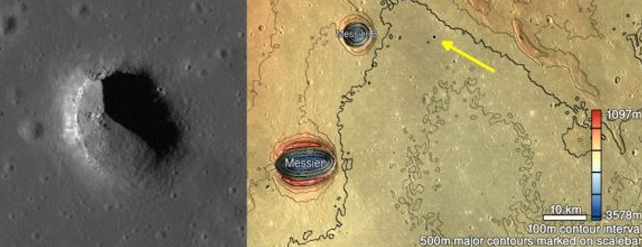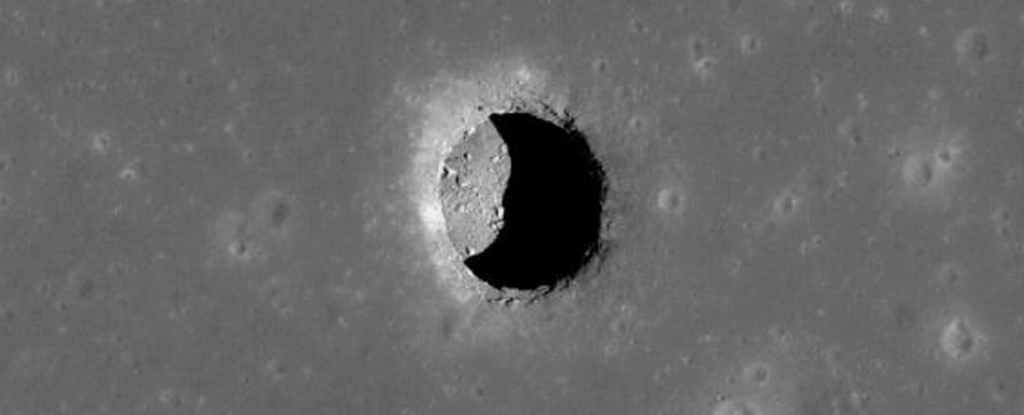Caves were some of humanity’s first shelters. Who knows what our distant ancestors were thinking as they sought refuge there, huddling and cooking meat over a fire, maybe drawing animals on the walls.
Caves protected our ancient ancestors from the elements, and from predators and rivals, back when sticks, stones, furs and fire were our only technologies.
So there’s a poetic parallel between early humans and us. We’re visiting the Moon again, and lunar caves could shelter us the way caves sheltered our ancestors on Earth.
On the Moon, astronauts will need protection from a different set of hazards. They’ll have to contend with cosmic and solar radiation, meteorites, wild temperature swings, and even impact ejecta.
The Lunar Reconnaissance Orbiter (LRO) has found hundreds of lunar ‘skylights,’ locations where a lava tube’s ceiling has collapsed, making a natural opening into the tube.
It’s hard to tell without exploring, but lava tubes several hundred meters in diameter could exist on the Moon. That’s a lot of room to work with, and they could provide the shelter astronauts will need. The idea is to build a base inside a lunar lava tube, where astronauts gain additional protection from the thick rock ceiling overhead.
China is considering the idea now, just like others before them. Lunar lava caves might be a resource too valuable to ignore.
Lava tubes are also called pyroducts. They formed when lava flowing across the surface of the Moon began to cool. The top of the flowing lava formed a hardened crust, but the molten lava kept flowing underneath it and eventually drained, leaving an empty tube. They’re here on Earth as well.
Scientists aren’t sure when lunar volcanism ended. It may have been as far back as one billion years ago, though some evidence shows there was small-scale volcanism in the last 50 million years. In either case, these lava tubes are ancient and untouched.
On the Moon, astronauts will have to contend with the temperature swings. Earth’s natural satellite is a world of temperature extremes. One side of the Moon is in direct sunlight for half of the time, and surface temperatures reach as high as 127 degrees Celsius (260 °F.) The side that’s shrouded in darkness sinks as low as -173 °C (-280 °F.)
That wild temperature swing makes it challenging to work on the lunar surface, and to engineer and build equipment that can be effective in such a large range. Lava tubes provide a natural steady-temperature environment that can’t be found elsewhere on the Moon.
Radiation is also hazardous on the lunar surface. It can be as much as 150 times more powerful than on Earth’s surface. That’s deadly, but in lunar caves astronauts would be sheltered by several metres of overhead rock. That’s a thick enough barrier to provide effective protection.
The risk of impacts and impact debris is much smaller, but it has to be accounted for. Obviously, lava tubes provide shelter from small impacts.
Different teams of scientists from different countries and agencies have studied the idea of using lava tubes as shelter. At a recent conference in China, Zhang Chongfeng from the Shanghai Academy of Spaceflight Technology presented a study into the underground world of lava tubes. Chinese researchers did fieldwork in Chinese lava tubes to understand how to use them on the Moon.
According to Zhang, there’s enough similarity between lunar and Earthly lava tubes for one to be an analogue of the other. It starts with their two types of entrances, vertical and sloped. Both worlds have both types.
Most of what we’ve found on the Moon are vertical-opening tubes, but that may be because of our overhead view. The openings are called skylights, where the ceiling has collapsed and left a debris accumulation on the floor of the tube directly below it. Entering through these requires either flight or some type of vertical lift equipment.
Sloped entrances make entry and exit much easier. It’s possible that rovers could simply drive into them, though some debris would probably need to be cleared. According to Zhang, this is the preferred entrance that makes exploration easier.
China is prioritizing lunar lava tubes at Mare Tranquillitatis (Sea of Tranquility) and Mare Fecunditatis (Sea of Fecundity) for exploration.

China is planning a robotic system that can explore caves like the one in Mare Tranquillitatis. The primary probe will have either wheels or feet and will be built to adapt to challenging terrain and to overcome obstacles. It’ll also have a scientific payload.
Auxiliary vehicles can separate from the main probe to perform more reconnaissance and help with communications and “energy support.” They could be diversified so the mission can meet different challenges. They might include multi-legged crawling probes, rolling probes, and even bouncing probes. These auxiliary vehicles would also have science instruments to study the lunar dust, radiation, and the presence of water ice in the tubes.
China is also planning a flight-capable robot that could find its way through lava tubes autonomously using microwave and laser radars.
China’s future plan, after successful exploration, is a crewed base. It would be a long-term underground research base in one of the lunar lava tubes, with a support center for energy and communication at the tube’s entrance. The terrain would be landscaped, and the base would include both residential and research facilities inside the tube.
China doesn’t have the same enthusiasm for information-sharing that an organization like NASA has, so details are more difficult to uncover. But there’s no question that China’s space activities are ascendant right now, with multiple successful missions completed, some still in progress, and future ones planned.
In the Spring of 2023, China announced plans to start building a Moon base by 2028, though it’s not clear if that announcement referred to a lunar lava tube base. That seems to contradict the most recent statement saying that China plans to “realize manned lunar landing by 2030.”
But regardless of when they start, China seems committed to the idea. Ding Lieyun, a top scientist at Huazhong University of Science and Technology, told the China Science Daily that “Eventually, building habitation beyond the Earth is essential not only for all humanity’s quest for space exploration but also for China’s strategic needs as a space power.”
This language almost exactly mirrors the language used by NASA when talking about its Artemis program.
In preparation for more lunar missions and an eventual base, Chinese researchers have studied both Mare Tranquillitatis and Mare Fecunditatis. In 2022 a team of scientists published a study on Mare Fecunditatis’ volcanic features in the journal Remote Sensing.
Mare Fecunditatis is rich in volcanic features, including lava tubes. The 2022 paper pointed out that no mission to the Moon’s surface has travelled more than 40 km (25 mi.) But that will change in the future.
The researchers behind this work propose a five-year long mission similar to NASA’s Mars rover missions. In five years, a Chinese rover could explore Mare Fecunditatis during a 1400 km (870 mi) traverse. By studying volcanic features like lava tubes, domes, and rilles, they would develop a more comprehensive understanding of the Moon’s regional geology. They may also select a site for a lunar base.
China is not the first to wonder about lava tubes as bases. The idea has been around for a long time. But before long, China and other spacefaring nations will be in a position to explore them, and to begin to get serious about building one.
Space exploration and politics are intertwined, and in China, they’re even more intertwined than other countries. The inner machinations of both are sometimes hidden behind an opaque wall, and details aren’t always readily available. It’s as if people are afraid of saying the wrong thing. But China’s intentions are clear, and if past is prologue, they’ll get to the Moon and build a base.
Maybe some of the Chinese taikonauts who eventually shelter in these lunar caves will spend a moment or two thinking about our ancient ancestors and how caves sheltered them. Maybe one of them will be the first human to make marks on the wall of a lunar lava tube.
Then one day, after humanity fades away, future alien explorers might find these marks and ponder their meaning.
This article was originally published by Universe Today. Read the original article.





